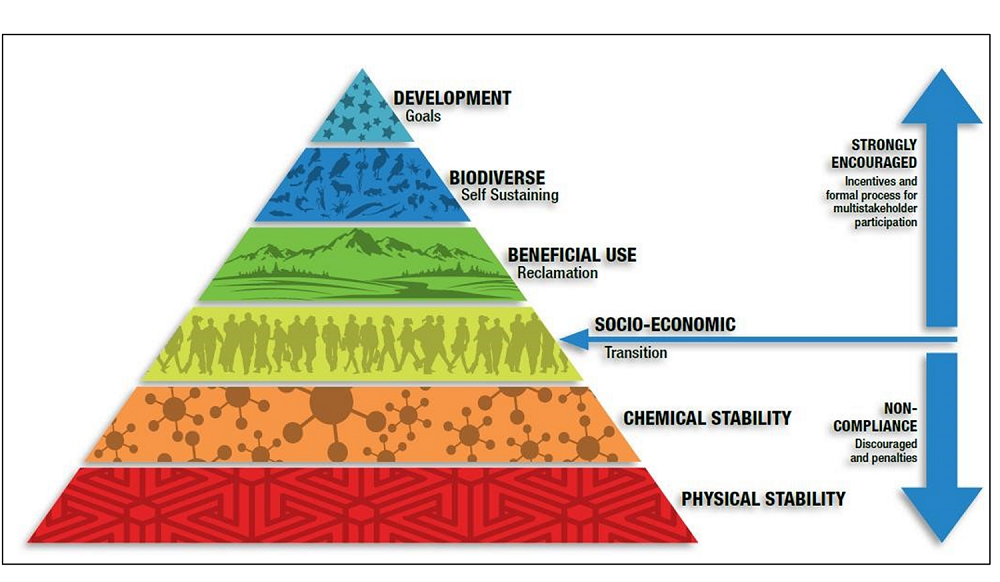Final Mine Rehabilitation and/or Decommissioning Plan

The Final Mine Rehabilitation and/or Decommissioning Plan (FMR/DP), also known as the Mine Closure Plan, is a plan for returning the mine sites and mining affected areas to viable and, whenever practicable, self-sustaining ecosystems that are compatible with a healthy environment and with human activities. The FMR/DP is composed of the following: final mine rehabilitation and/or decommissioning plan, social plan, and maintenance and monitoring plans which shall be implemented during the cessation of the mining operation. Further, the FMR/DP is a guarantee that the most appropriate science-based mine rehabilitation/decommissioning measures will be implemented with financial surety upon closure of the mine.
Legal Basis
The following are the legal bases for the preparation, submission and implementation of the FMR/DP:
- Section 69 of Republic Act (RA) No. 7942, the Philippine Mining Act of 1995
- Section 167 and 187 of Chapter XVI of the Consolidated Department of Environment and Natural Resources Administrative Order (DAO) No. 2010-21, the Revised Implementing Rules and Regulations RA No. 7942, the Philippine Mining Act of 1995
- Executive Order (EO) No. 270-A in re: Amending EO No. 270, National Policy Agenda on Revitalizing Mining in the Philippines
- Section 7 of the DENR Memorandum Order No. 99-32, Policy Guidelines and Standards for Mine Wastes and Mill Tailings Management
Scope
All Contractors/Permit Holders including those whose contracts/permits are revoked/cancelled/terminated shall be covered by these guidelines.
These guidelines provide a blueprint for the Contractors/Permit Holders in the implementation of the FMR/DP; and the Mines and Geosciences Bureau Central/Regional Office in the review, evaluation, monitoring and audit of the FMR/DP implementation.
Guiding Principles
The preparation and implementation of the FMR/DP shall be guided by the following principles:
1. Principles of Sustainable Development and Sustainability
Sustainable development is defined as the development that meets the needs of the present generation without compromising the ability of future generations to meet their own needs (Brundtland, 1987). Sustainability, on the other hand, entails a systems-based approach of understanding the interactions among environmental, social and economic pillars (Figure No. 1).

Figure No. 1. Three Pillars of Sustainability (United Nations World Summit on Sustainable Development, 2002)
Mine closure activities shall be conducted in a manner that contributes to the Sustainable Development Goals (SDGs) - the universal call to action to end poverty, protect the planet and improve the lives and prospects of everyone. In general, the following aspects in relation to SDGs shall be highlighted in the conduct of the implementation of the FMR/DP: protection and conservation of life on land, provision of clean water and sanitation, use of energy-efficient activities/processes, implementation of measures that will address climaterelated environmental impacts, and creation of jobs and economic growth.
The preparation and implementation of the FMR/DP shall also be guided by the following:
- Preparation should be in consultation with the communities, local government units (LGUs), and government agencies concerned in accordance with the existing rules and regulations of the government;
- Cost-effective transformation of mined-out areas into a physically and chemically stable, visually acceptable, and self-sustaining ecosystem in consonance with regulatory standards;
- Consideration of all mine closure scenarios with cost estimates for its implementation, taking in consideration expected inflation, technological advances, the unique circumstances faced by the mining operation using riskbased methodologies/approaches; and
- Establishment of a final mine land use that is functional and proximate to the land use prior to the disturbance of the mine area, unless more beneficial land uses are predetermined and agreed in partnership with local communities and LGUs.
Goal and Objectives
The goal of the FMR/DP is to safeguard the life of the people and the environment upon mine closure.
Enshrined in the guiding principles of the FMR/DP, these guidelines aim to ensure that the mine closure objectives will achieve the following conditions based on the hierarchy of mine closure needs (Figure 1):
- Physical Stability – The ability of the project to withstand failure or physical deterioration and not to pose hazard to public health and safety. Upon mine closure, the risk of the failure of the project and the required level of maintenance is acceptably low.
- Chemical Stability – The ability of the project to prevent the release of chemicals or contaminants into the environment. During mine closure, activities may be enhanced by providing a system of containment, collection and treatment systems using proven techniques.
- Socio-economically prepared community – The ability of the community to have a positive transition on being responsible, self-reliant, self-managed and resource-based communities upon mine closure.
- Visual Acceptability – The ability of the project component to blend with the surroundings. The footprint of previous mining/mineral processing operations shall be rehabilitated or decommissioned into a land use beneficial to the environment and the community.
- Productive or self-sustaining ecosystem – The ability of the rehabilitated areas to transform into productive ecosystems thereby achieving ecosystem services. Self-sustaining ecosystem shall mean that the final use can be sustained by natural processes and will not require actions by man.
- Conformity with Development Goals – The Mine Closure Plan shall be holistic in terms of mobilization of human, physical, technological and financial resources to achieve the sustainable development goals of mining industry.

Figure 1. Hierarchy of Mine Closure Needs. Source: APEC Mine Closure Task Force, 2018
Reports and Infographics
- Annual Final Mine Rehabilitation and/or Decommissioning Plan (FMRDP) (2023) , (2022), (2021), (2020), (2019)
- Final Mine Rehabilitation and/or Decommissioning Plan (FMRDP) by Region (2023) , (2022), (2021), (2020), (2019)
- Final Mine Rehabilitation and/or Decommissioning Plan (FMRDP) by Province (2023) , (2022), (2021), (2020), (2019)
- Final Mine Rehabilitation and/or Decommissioning Plan (FMRDP) by Mining Company (2023) , (2022), (2021), (2020), (2019)
Go back to SHES Corner Main Page
